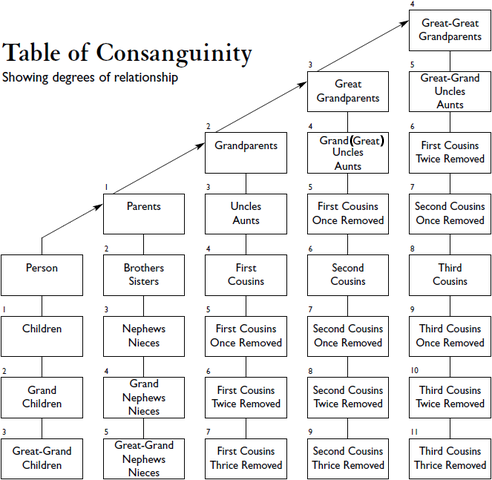| Pritz Family Genealogy Website Guide - Tree Terminology 10 August 2016 |
Herein we provide a glossary of sorts for words and terms used to describe a family tree, the people in it, their relationships, and the associated genealogy.
Genealogy or family history: - the study of families and the tracing of their lineages and history (from Wikipedia.
An ancestor or forebear is a parent or (recursively) the parent of an ancestor (i.e., a grandparent, great-grandparent, great-great-grandparent, and so forth) - from Wikipedia.
The words ancestry, pedigree, and lineage refer to a multi-generational collection of ancestors usually branching backward in time and generations from one ancestral line lineage. Sometimes these words include collateral relatives.
Descendant: An offspring or child of a particular person/parent or pair of parents.
Branch: In genealogy, a branch refers
to two very different groups of relatives.
An ancestral branch is a
line of relatives diverging backward in time from a Lineal Ancestor. For
example, your Mother's Mother is the start of an ancestral branch of your
family which blossoms backward in time.
A descendant branch is a line
of relatives diverging forward in time from a Collateral Ancestor. For example,
your Aunt and her descendants form one of the descendant branches of your
family which blossom forward in time.
(From
TNG Glossary.)
Lineal ancestor: A lineal ancestor or relative is a direct ancestor - parent, grandparent, great grandparent, and so on back in time. Each lineal ancestor is a founder of an ancestral Branch on your family tree. Often the female ancestral branches become more difficult to research as you go back in time because their surname was not recorded in earlier birth, marriage, and death records. (From TNG Glossary.)
Line and lineage: Usually refer to a specific multi-generational chain of either ancestors or descendants with the same surname (family name, last name).
Collateral ancestor: A collateral ancestor is a brother or sister of a Lineal Ancestor. For example, your GrandMother's brother - your GrandUncle - is one of your collateral ancestors. He is related to you because you both descended from your GrandMother's parents; but you did not 'descend' from your GrandUncle, that is, you are not one of his GrandChildren. (From TNG Glossary.)
Collateral descendant: A collateral descendant is a descendant of a Collateral Ancestor. For example, your Uncle is a collateral ancestor; so his children - your cousins - are collateral descendants.Each collateral ancestor who has a child is the founder of a separate descendant Branch on your family tree. (From TNG Glossary.)
Common Ancestor(s) or Most Recent Common Ancestor(s) (MRCA): An ancestor that two or more descedants have in common. The plural form (common ancestors) usually refers to the male and female pair of common ancestral parents. For example, Benjamin Pritz and Emelia B. Heineman are the common ancestors (actually MRCA) of Neil A. Pritz and Stephen Heldman who are second cousins to each other.
Consanguinity: (from Wikipedia) The quality of being descended from the same ancestor as another person. The degree of relative consanguinity can be illustrated with a consanguinity table with each generation sharing a row.

The number in each box indicates the degree of relationship.
The words Grand and Great are used to denote successive generations of ancestors or descendants, as shown in the above Table of Consanquinity. Often, when going back further generations beyond Great Grandparents, such as Great Great Grandparents, then the shorthand wording of Second Great (2nd Great) Grandparents is used. Thus the preceding generations of ancestors would then be 3rd Great Grandparents, 4th Great Grandparents, etc.
Grand versus Great: Siblings of your Parents are your Aunts and Uncles. Thus one would think that the siblings of your Grandparents would be your Grandaunts and Granduncles. And indeed they are. However, it is common practice, although not preferred, to call the siblings of your Grandparents your Great Aunts and Great Uncles. But this can lead to more confusion going back further generations. So it is recommended to use the words Grandaunt and Granduncle consistently, such as the siblings of your Great Grandparent being your Great Grandaunt or Great Granduncle.
The word Removed is used to denote cousins who are one or more generations removed from each other. That is, they are on different generation levels in terms of descent from their common ancestors. For example, Neil A. Pritz is a Second Cousin Once-Removed from Chris Heldman.
Full, Half, and Step: A full sibling is a brother or sister that has the same mother and father as you do. On the other hand, half siblings only share one parent, either their father or their mother. So full and half siblings are "blood relations" - or biological relations. Step brothers and sisters are only related through the marriage or their parents, that is, they do not have the same biological parents.
The BMD: This is shorthand for the basic genealogical data for an individual or a group of people consisting of their birth date and location, marriage date and location, and death date and location.
GEDCOM Data File: This is a text file format that is widely used to share genealogical data. A GEDCOM file contains the genealogical data (no images or documents) exported from a family tree. It is commonly used as a way to transfer data between genealogical or family tree software programs. For example, a GEDCOM data file exported from this tree and downloaded can be imported into PC-based family tree programs such as RootsMagic or Family Tree Maker. For creation of a GEDCOM file from this tree see: GEDCOM tab in the Site and Tree Navigation guide. For more general and technical information on the GEDCOM data file format and its uses see GEDCOMs Explained and What is GEDCOM?.
For further information see the Encyclopedia of Genealogy.